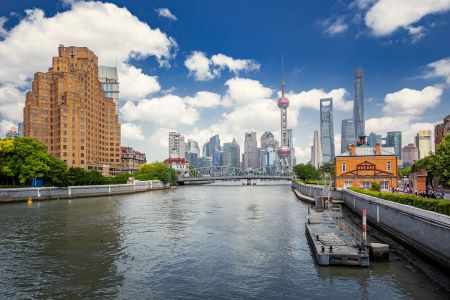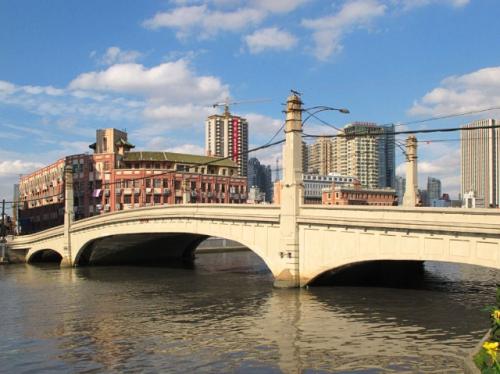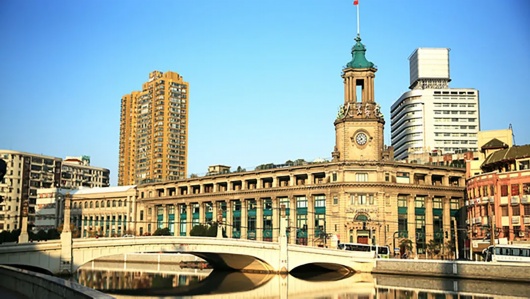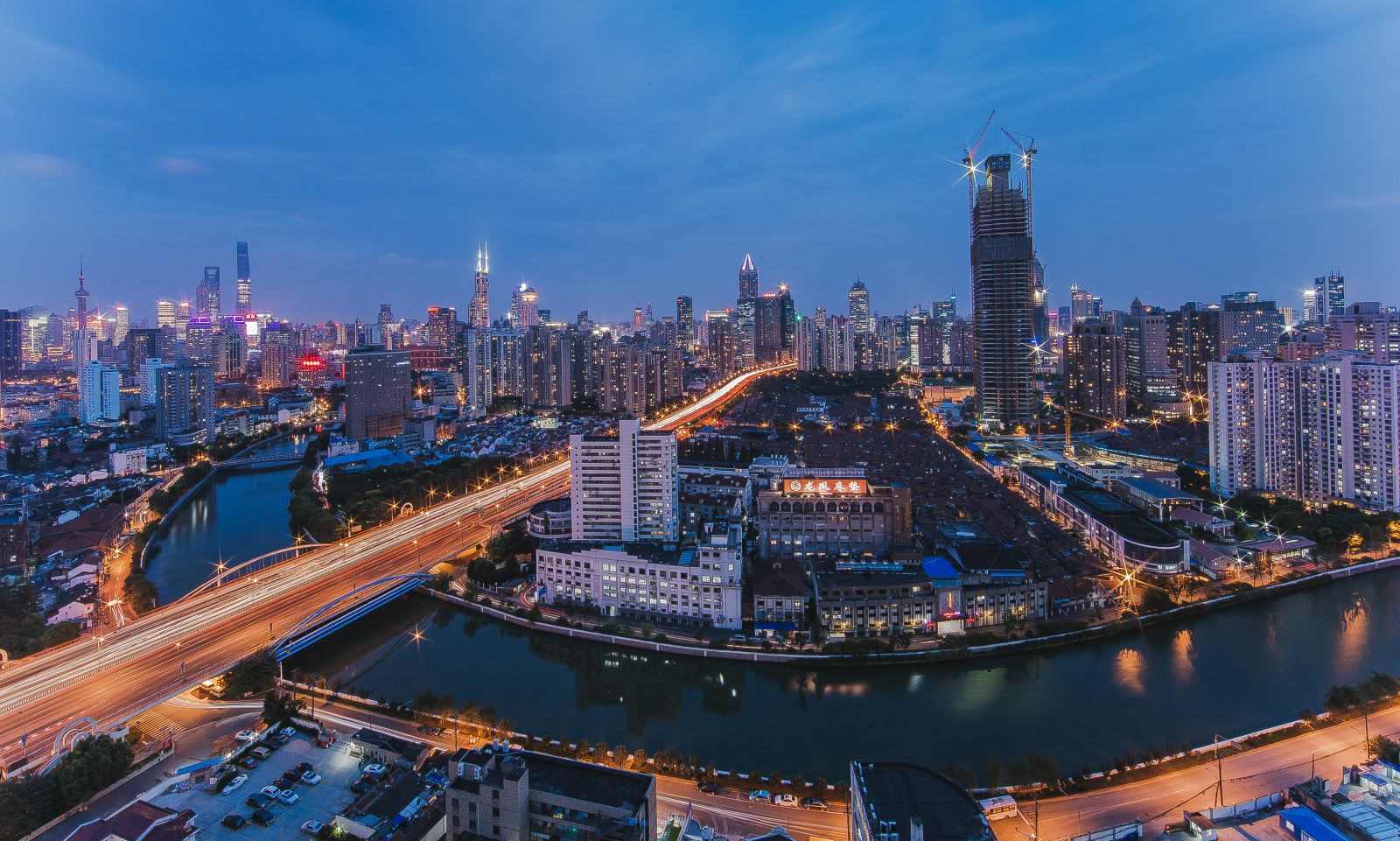Chinese Name: 苏州河 Pronunciation: Sūzhōu Hé
Address: Huangpu District, Shanghai, China
Length: About 54 km in Shanghai
Formation Time: 5,000 years ago

Suzhou Creek, the second largest river in Shanghai, is known as the “Natural Bridge Museum”. Suzhou Creek is 125 km long in total and 54 km long in Shanghai. It is an important waterway in the urban area of Shanghai and the main water transportation line from Shanghai to Jiangsu Province. For Shanghai people, Suzhou Creek is not only a place name but also carries the memory of Shanghai’s changes.
Suzhou Creek was originally named Wusong River. During the concession period, foreign nationals often took boats from Shanghai to Suzhou, so the name of Suzhou Creek came into being. For old Shanghainese, Suzhou Creek is more than a place name. This river which separates the prosperous concession from the dilapidated lanes is endowed with a unique artistic atmosphere by many artists. The winding Suzhou Creek is just like the historical context, witnessing the changes of Shanghai.
Suzhou Creek flows into Huangpu River from west to east. In the process of Shanghai’s urbanization, the British Consulate, Ritz Hotel, Broadway Mansions, St. John’s University, and other excellent buildings were built along the coast.
Both sides of Suzhou Creek used to be the gathering place of large-scale factories. In recent years, the government has made great efforts to renovate the factories, and the factories have gradually moved out of the Suzhou Creek area. Many painters and artists take advantage of these open workshops and rent them as studios and galleries. The most representative is the M50 Creative Park. Compared with the Art Street on Taikang Road, there are more rugged warehouse styles here, which are very distinctive.
Sihang Cangku (Sihang Warehouse) is located on the north bank of Suzhou Creek. From October 26 to November 1, 1937, the Defense of Sihang Warehouse revived the morale of the Chinese army and people who were frustrated by the Battle of Songhu. The Chinese soldiers who took part in this war were called “The Eight Hundred”.
On August 13, 1937, the Battle of Songhu broke out. Hundreds of thousands of Chinese and Japanese armies fought for more than two months. By the end of October, the Chinese army had withdrawn from Shanghai, leaving only one force that insisted on the final resistance.
From October 26 to 30, 1937, all the soldiers of the First Battalion, 524th Regiment of the 88th Division of the Kuomintang government army, after covering the retreat of the army, were ordered to enter the Sihang Warehouse to keep their position. These soldiers fought hard in bloody battles with the Japanese army in Sihang Warehouse for four days and nights, repelling the enemy's repeated attacks and shaking the enemy's courage. They were well-known both at home and abroad and were known as “The Eight Hundred”.

The Sihang Warehouse is a concrete building with great thickness, which was the highest building in the area. Japanese tanks couldn’t break through its concrete walls. The Sihang Warehouse was just across the Suzhou Creek from the British concession so the Japanese army did not dare to bomb the Sihang Warehouse with heavy artillery and bombs.
Suzhou Creek became a fragile barrier separating “War” and “Peace”. A large number of refugees swarmed into the concession through various bridges on Suzhou Creek to seek refuge from the war.

The first bridge of Suzhou Creek was built at the end of the 19th century, that is, the “Wells Bridge” connecting the British and American concessions at that time. Originally the bridge was a wooden structure. In the 1920s, another steel bridge was built on its side, the famous “Garden Bridge of Shanghai” (Waibaidu Bridge).
From the end of the 19th century to the first half of the 20th century, 18 bridges were built over Suzhou Creek in Shanghai. Most of the bridges built in the 19th century were wooden structure, but they were changed to reinforced concrete structures in the early 20th century. Many of these bridges were built or rebuilt by the Ministry of Industry of the concession so most of them are concentrated in the east section of Suzhou Creek, and most of them have a strong style of European urban arch bridges.
The youngest bridge is Luding Road Bridge built in 2010. Changshou Road Bridge, built in 1953, is the first bridge across Suzhou Creek built after the liberation of Shanghai.

Suzhou Creek, as a witness of modern Shanghai, retains many typical Western-style buildings, such as the Shanghai General Post Office, former British Consulate, Shanghai Chamber of Commerce, and various luxury hotels. All the buildings constitute the nostalgic landscape of Shanghai. These buildings are part of the history of the city. When you look at the buildings along the river, you seem to return to the old Shanghai.
Shanghai General Post Office, located at the north end of Sichuan Road Bridge, is the highlight of the building. Built in the 1920s, the eight-story building has a baroque terrace on top. The completion of the Shanghai General Post Office became a great event in Shanghai at that time because it was the first steel structure and brick wall building in Shanghai.

M50 Creative Park is located on Moganshan Road, Putuo District, Shanghai. M50 Creative Park, originally an old Shanghai woolen mill, has been transformed into an art creative park since 2000. The whole park covers an area of about 24,000 square meters. M50 Creative Park takes “art, creativity, and life” as its core value.
In recent years, M50 Creative Park has introduced more than 140 artists’ studios, galleries, and various cultural and creative institutions from 20 countries and regions. The presence of these institutions has created a strong artistic and creative atmosphere along Suzhou Creek, attracting many collectors, media, celebrities, art lovers, citizens, and tourists at home and abroad.
The best time to visit Suzhou Creek is from March to May and from September to November when the weather is good. You can enjoy the beautiful scenery and have a good chance to take clear and good-looking photos.
1. If you decide to visit Suzhou Creek on a cold day, remember to bring your coat. When you stand by the river, it will be very cold. There will be a little fog on rainy days so some of the sceneries nearby may become blurred.
2. When you participate in water activities, please put on your life jacket. When you take water boats, you should obey the command of the safety officer.
As Suzhou Creek is a long river of Shanghai, you can go to Waibaidu Bridge to have a look.
Take bus no.934, no.330, no.37, no. 868, or no.135, and get off at Baiduqiao Station, and then walk about 400 meters to the river bank of Suzhou Creek.
Take Subway line 10 or line 12, and get off at Tiantong Road Station. Then, you can walk to the riverside of Suzhou Creek.
Chinese: 请带我去外白渡桥。English: Please take me to Waibaidu Bridge.
If you go to Waibaidu Bridge from Shanghai Pudong International Airport, it takes about 60 minutes (about 170 yuan).
If you go to the Waibaidu Bridge from Shanghai Railway Station, it takes about 20 minutes (about 25 yuan).
If you go to Waibaidu Bridge from Shanghai Hongqiao International Airport, it takes about 45 minutes (about 70 yuan).
